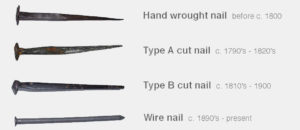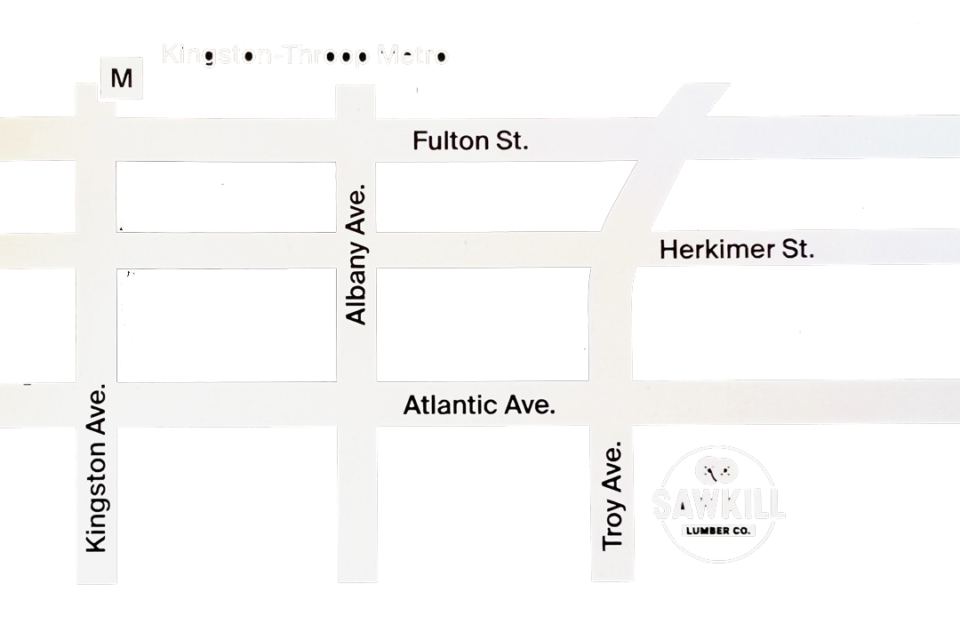 Many things hold NYC together – education, diversity, sustainability, architecture, preservation, sports teams, economy, transportation, terrorism (temporarily) – and nails. Old joists and timbers in city buildings may contain a few generations of this essential building item. Nails are one of the clues to the age of a city building, especially ones that date from the nineteenth century, when nail-making was developing quickly.
Many things hold NYC together – education, diversity, sustainability, architecture, preservation, sports teams, economy, transportation, terrorism (temporarily) – and nails. Old joists and timbers in city buildings may contain a few generations of this essential building item. Nails are one of the clues to the age of a city building, especially ones that date from the nineteenth century, when nail-making was developing quickly.
Like the wheel, there’s no record of the first person that had the idea to join two pieces of wood with a nail. But nails have been around since Roman times 2000 years ago. By the 1800‘s, England was the largest nail-making country in the world, with 60,000 people employed in Birmingham nail manufacturing alone. But the evolution of nail making was essentially the product of American Yankee ingenuity. The following briefly marks the nails time line within the built environment.
1700 to 1800 – Hand-wrought nails made by a blacksmith from square iron rods were used. Iron was drawn into rods, the end heated and formed by hammer on an anvil with four quick blows, forming a type of rose head. The rod was re-heated and the process was repeated. It was much lighter work than other types of metalsmithing, and often done by women and children. For this reason, it was among the dark spots from the industrial era, motivating machine advances in the process.
1790s to early 1800s – Machines were invented in the United States for making nails from bars of iron, shearing nails off like a guillotine, with a taper formed by wiggling the bar from side to side with every stroke. The heads were made as before, struck into a rose head by hammer blows on an anvil. These became known as type A cut nails. Eventually, machines were developed that pounded a head on the end of each nail mechanically. This type of nail was made until the 1820s.
Early 1800’s – late 1800’s – In the USA, towards the late 1700′s and early 1800′s, a nail machine was invented. It had three parts. Flat metal strips about two feet long fed into the machine. One lever cut a triangular strip of metal, a second lever held the nail in place, while the third lever formed the head. The strip of metal was then turned around 180° to cut the next equal and opposite nail shape off the strip. The nails were known as “cut nails”. But still, the process was labour intensive with a man (or woman) at each machine. Nails made by this method are known as type B nails. And these are the nails most commonly found in many 19th c. New York City buildings today. Type A nails and the later type B nails can be distinguished by a small burr along the edge or the Type A. Both of these types are inexact, with each nail looking just slightly different. With exposure to time and the elements, the iron nails can begin to corrode, and slightly ‘bleed’ into the surrounding wood, leaving the ingrained mark of it’s history, without compromising the woods structural re-use.
Late 1800‘s – With the rapid development of steel making through the Bessemer process during the 1880s, iron nail making dropped off. By the 1880’s, 10 percent of the nails produced in the United States were made of steel wire. Within six years, more steel-wire nails were being produced than Class B cut nails. By 1913, 90 percent were wire nails.
In the early 1900′s, the first coils of steel round wire were produced and quickly machines were designed to use this new raw material. And the first automatically produced wire nails with no human intervention other than to set up the machine immediately showed that this was the future.
Additional sources:
Whorf, Amy. A Thumbnail History of Nails, Country Living, June 1993, p. 72.
Sloane, Eric A Reverence for Wood, Dover Publications, 2004.
Bolles, Albert Sidney Industrial history of the United States, from the earliest settlements to the present time: being a complete survey of American industries.
Henry Billing Publishing, 1889.
http://www.glasgowsteelnail.com/nailmaking.htm
http://www.madehow.com/Volume-2/Nail.html
http://www.uvm.edu/histpres/203/nails.html


